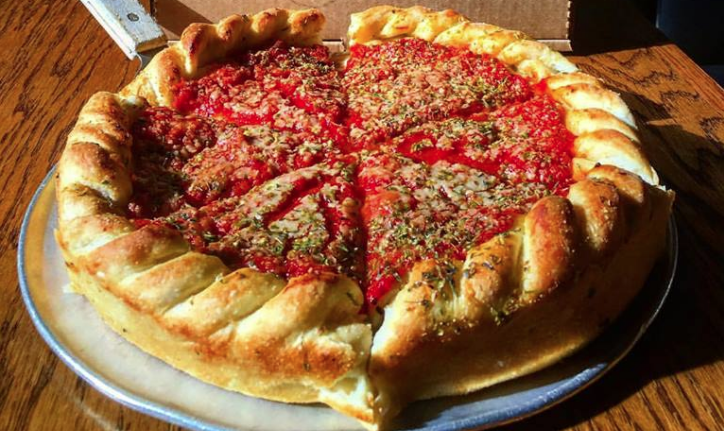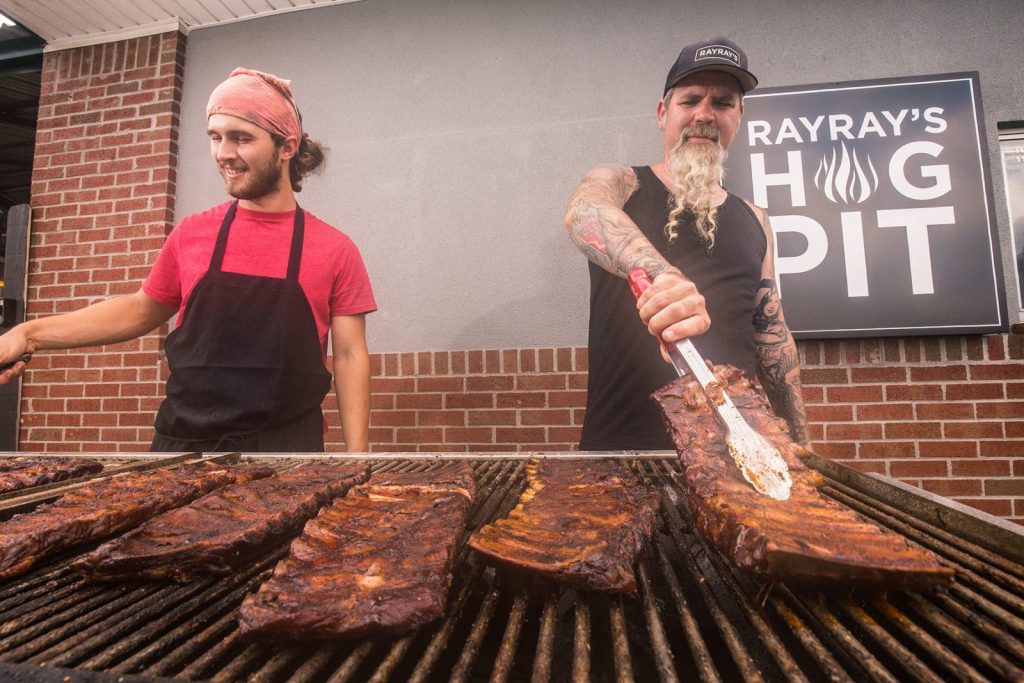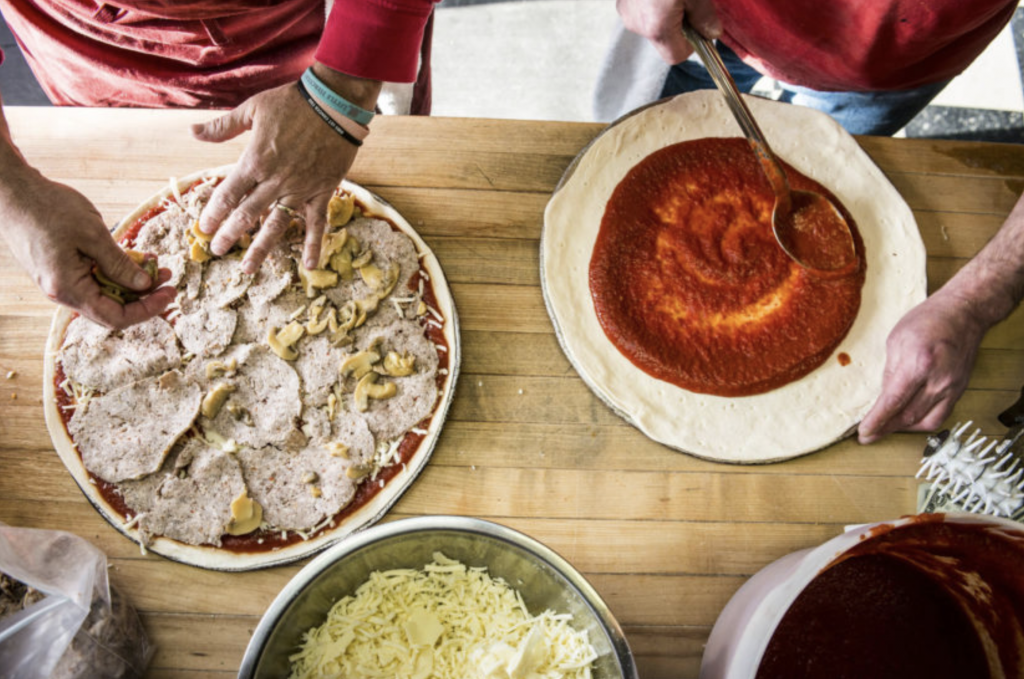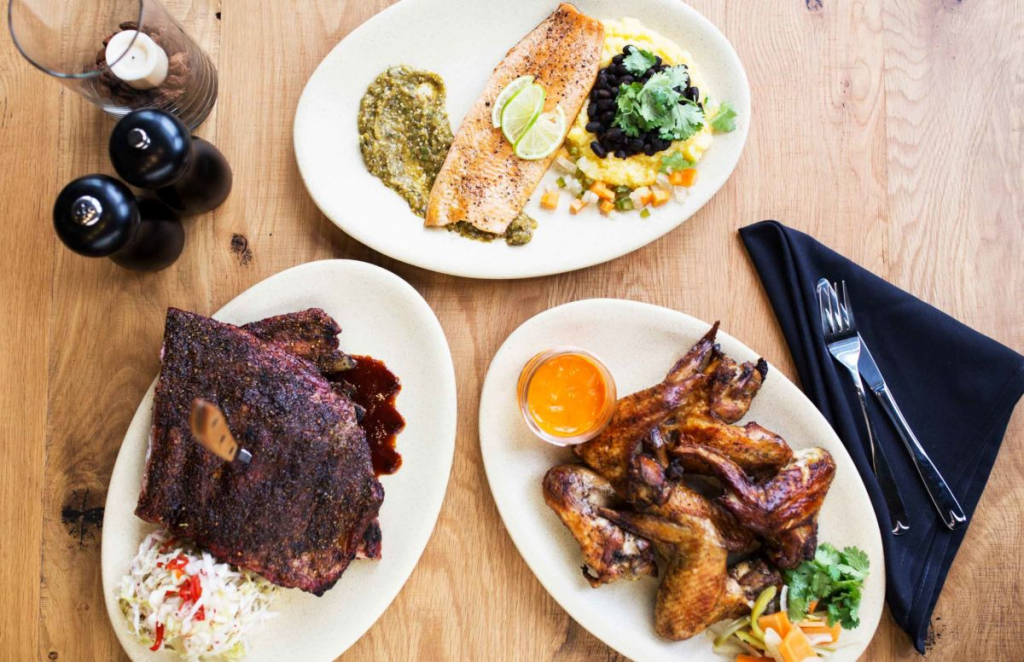Originally published in the November 2017 issue of (614) Magazine

“It’s a lovely casserole, but it’s not a pizza,” quipped an equally opinionated eater as we disputed the defining design of a true Chicago pie.
The Gold Coast isn’t alone in its claim of a signature style. Foldable New York slices are well known, with regional variations from New Jersey to New Haven. California has its quirky toppings and St. Louis a unique blend of provolone, Swiss, and white cheddar. Detroit deep-dish gets its square shape and crunchy corners from blue steel parts pans pinched from auto assembly lines. Milwaukee might be the closest to our own familiar fare, with square slices and curled nickel pepperoni on a flaky thin crust.
Perhaps the reason many still dispute “Columbus Pizza” as its own distinct style is because we’re not pizza purists averse to new ideas or unexpected twists on a classic dish. Critics didn’t go crazy when Leone’s topped their pie with wild mushrooms, rosemary, and truffle oil. Nor did anyone cry foul when Clever Crow scattered corn on one either. We’re a working-class town with working-class tastes and no patience for petty pizza punditry. We don’t forego thumping our chests because we’re mediocre — we’re just magnanimous.
That’s probably why Giordano’s decided to open their first location outside greater Chicago near Polaris. The midpoint between Delaware and Downtown is effectively our backyard with the right mix of local and national retail brands to make their first foray in America’s test market a solid start toward inevitable expansion.
Pizzeria Uno made a nationwide push years ago with some success, but still lacked the street cred of Giordano’s. Uno seemed to abandon craft to become a commodity, a strategy that initially worked for Shakey’s, America’s first franchised pizza “parlor”. And yet, good luck finding a Shakey’s today, aside from the handful left in California or the Philippines.
To understand the curious appeal of Chicago’s claim to pizza fame, you have to understand what it is — and what it isn’t. “Deep Dish” and “Chicago Style” are not synonymous. They’re certainly farther removed than their hand-tossed and hand-stretched cousins. Commonly called “Sicilian”, deep dish is all about the crust, and not just the edge. Its thick, airy, and chewy throughout with a base of sauce covered in cheese and toppings. Chicago-style crust is high on the sides, but only thick enough in the middle to contain layers of filling with the order often reversed — cheese on the bottom, toppings, then sauce. That’s why a deep-dish pizza takes a little longer than a more traditional one, but a Chicago-style pizza takes closer to an hour.
Though the exposed brick and industrial accents are the unspoken standard for culinary concept restaurants, Giordano’s stays true to its roots with solid service and pizza that’s worth the wait. But, they haven’t cornered the market here in Central Ohio either. Loyal fans of Chicago’s legendary Lou Malnati’s, Pequod’s caramelized crust, and the ever-eccentric Burt’s Place would still be quick to throw down over who has the best pizza in their town.
Columbus similarly boasts a trio of worthy rivals to Giordano’s recent entry into the city’s established Chicago-style pizza scene.
Wholly Joe’s Chicago Eatery | 1182 E Powell Road
Don’t let the strip mall sign with only “hot dogs” underneath fool you. On the opposite end of Polaris Parkway hides a hat trick of Windy City staples. Yes, the hot dogs are authentic: Red Hot Chicago brand dogs with mustard, relish, chopped onions, sliced tomato, cucumber, kosher spear, and sport peppers on a poppy seed bun. (You can also grab a Polish sausage the same way, or like they’re served on Maxwell Street, with mustard and grilled onions.) The Italian beef is best ordered, “hot and wet”, with spicy giardinera and the whole roll dipped in the drippings.
Hidden in the kitchen is an old-school carousel pizza oven. It took two years just to find all of the parts to restore the 1951 oven to original operating condition. The rotating decks cook the center to perfection and bottom just right, without burning the outer crust. Pizza is only available evenings and weekends, but it may be as close as you get to an all-around taste of Chicago that doesn’t involve a short flight or a long drive.
Meister’s Bar | 1168 Chambers Road
Columbus bar fare is often far better than most restaurants. Even our dive bars defy expectations. Between King and Kinnear is the home of one of the best pizzas in the city. (Really, I’m pretty sure the place used to be a house.) Craft beer is on tap, but if you’re looking for two-buck PBRs or dollar cans, the daily beer specials are budget-friendly. Yes, it’s a sports bar of sorts, but it’s worth the sometimes-tight seating just for the pizza.
The golden crust is a little thicker in the middle than some Chicago-style pies, but the high sides and sauce sequence place it well within spec. If you’re a local, you can likely order when they open at 4pm and have it out of the oven in less time than it takes to get to Polaris at rush hour. The proximity to OSU also means they’re open late. Just don’t be the putz who shows up ten minutes before closing for a carry-over order that takes an easy 45 minutes before it hits the box.
Yellow Brick Pizza | 892 Oak Street
How do you get instant street cred for your Chicago-style pizza? You bring in a master to teach your staff how it’s done. When Lou Tristano decided to close his Grove City restaurant last year, Yellow Brick stepped in to ensure his pizza proficiency didn’t disappear as well. Though Olde Towne East is far from the suburb Tristano’s called home, the pizza is pretty damned close, right down to the braided edge on the crust that makes it easy to spot in your friends’ Instagram feeds.
Sure, there was a little hushed fuss about Yellow Brick serving the already famous pie, but pay that no mind. No one poached a pizza here, and Yellow Brick’s menu was already as unexpected and outside-the-box as a pizza place could get. (Hell, Hounddog’s is still serving Smokin’ Joe’s crust more than a decade later.) Lou’s legacy lives on in his pizza, and working with him to preserve it earns high marks for Yellow Brick and a city that collaborates as enthusiastically as it competes and eats. Columbus is a big pie, there’s plenty for everyone. ▩






